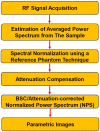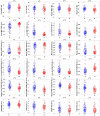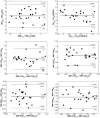Implementation of Non-Invasive Quantitative Ultrasound in Clinical Cancer Imaging
- PMID: 36551702
- PMCID: PMC9776858
- DOI: 10.3390/cancers14246217
Implementation of Non-Invasive Quantitative Ultrasound in Clinical Cancer Imaging
Abstract
Quantitative ultrasound (QUS) is a non-invasive novel technique that allows treatment response monitoring. Studies have shown that QUS backscatter variables strongly correlate with changes observed microscopically. Increases in cell death result in significant alterations in ultrasound backscatter parameters. In particular, the parameters related to scatterer size and scatterer concentration tend to increase in relation to cell death. The use of QUS in monitoring tumor response has been discussed in several preclinical and clinical studies. Most of the preclinical studies have utilized QUS for evaluating cell death response by differentiating between viable cells and dead cells. In addition, clinical studies have incorporated QUS mostly for tissue characterization, including classifying benign versus malignant breast lesions, as well as responder versus non-responder patients. In this review, we highlight some of the important findings of previous preclinical and clinical studies and expand the applicability and therapeutic benefits of QUS in clinical settings. We summarized some recent clinical research advances in ultrasound-based radiomics analysis for monitoring and predicting treatment response and characterizing benign and malignant breast lesions. We also discuss current challenges, limitations, and future prospects of QUS-radiomics.
Keywords: cell death; chemotherapy; locally advanced breast cancer (LABC); quantitative ultrasound (QUS); radiotherapy; treatment response.
Conflict of interest statement
The authors declare no conflict of interest.
Figures







Similar articles
-
Early Changes in Quantitative Ultrasound Imaging Parameters during Neoadjuvant Chemotherapy to Predict Recurrence in Patients with Locally Advanced Breast Cancer.Cancers (Basel). 2022 Feb 28;14(5):1247. doi: 10.3390/cancers14051247. Cancers (Basel). 2022. PMID: 35267555 Free PMC article.
-
Quantitative ultrasound radiomics guided adaptive neoadjuvant chemotherapy in breast cancer: early results from a randomized feasibility study.Front Oncol. 2024 Apr 19;14:1273437. doi: 10.3389/fonc.2024.1273437. eCollection 2024. Front Oncol. 2024. PMID: 38706611 Free PMC article.
-
Quantitative ultrasound radiomics using texture derivatives in prediction of treatment response to neo-adjuvant chemotherapy for locally advanced breast cancer.Oncotarget. 2020 Oct 20;11(42):3782-3792. doi: 10.18632/oncotarget.27742. eCollection 2020 Oct 20. Oncotarget. 2020. PMID: 33144919 Free PMC article.
-
A Review of Ultrasound Tissue Characterization with Mean Scatterer Spacing.Ultrason Imaging. 2017 Sep;39(5):263-282. doi: 10.1177/0161734617692018. Epub 2017 Mar 6. Ultrason Imaging. 2017. PMID: 28797220 Review.
-
Review of Quantitative Ultrasound: Envelope Statistics and Backscatter Coefficient Imaging and Contributions to Diagnostic Ultrasound.IEEE Trans Ultrason Ferroelectr Freq Control. 2016 Feb;63(2):336-51. doi: 10.1109/TUFFC.2015.2513958. Epub 2016 Jan 8. IEEE Trans Ultrason Ferroelectr Freq Control. 2016. PMID: 26761606 Free PMC article. Review.
Cited by
-
High-frequency quantitative ultrasound in characterizing human skin aging: an exploration of the non-modeling and modeling approaches.Quant Imaging Med Surg. 2025 Jul 1;15(7):6372-6385. doi: 10.21037/qims-24-1753. Epub 2025 Jun 30. Quant Imaging Med Surg. 2025. PMID: 40727367 Free PMC article.
-
Quantitative Ultrasound for Evaluation of Tumour Response to Ultrasound-Microbubbles and Hyperthermia.Technol Cancer Res Treat. 2023 Jan-Dec;22:15330338231200993. doi: 10.1177/15330338231200993. Technol Cancer Res Treat. 2023. PMID: 37750232 Free PMC article.
-
H-Scan Discrimination for Tumor Microenvironmental Heterogeneity in Melanoma.Ultrasound Med Biol. 2024 Feb;50(2):268-276. doi: 10.1016/j.ultrasmedbio.2023.10.012. Epub 2023 Nov 22. Ultrasound Med Biol. 2024. PMID: 37993356 Free PMC article.
References
-
- Sadeghi-Naini A., Papanicolau N., Falou O., Zubovits J., Dent R., Verma S., Trudeau M., Boileau J.F., Spayne J., Iradji S., et al. Quantitative Ultrasound Evaluation of Tumor Cell Death Response in Locally Advanced Breast Cancer Patients Receiving Chemotherapy. Clin. Cancer Res. 2013;19:2163–2174. doi: 10.1158/1078-0432.CCR-12-2965. - DOI - PubMed
Publication types
LinkOut - more resources
Full Text Sources

